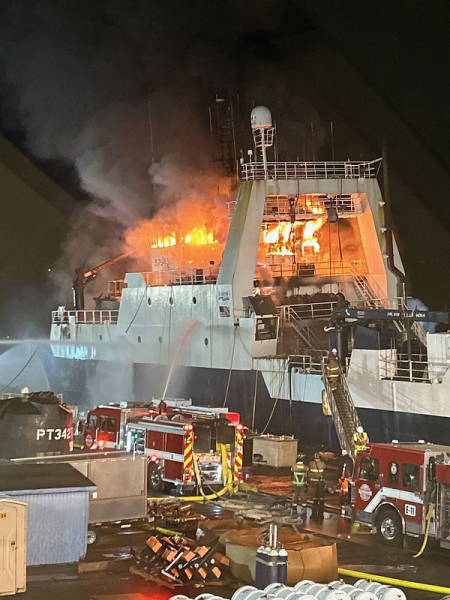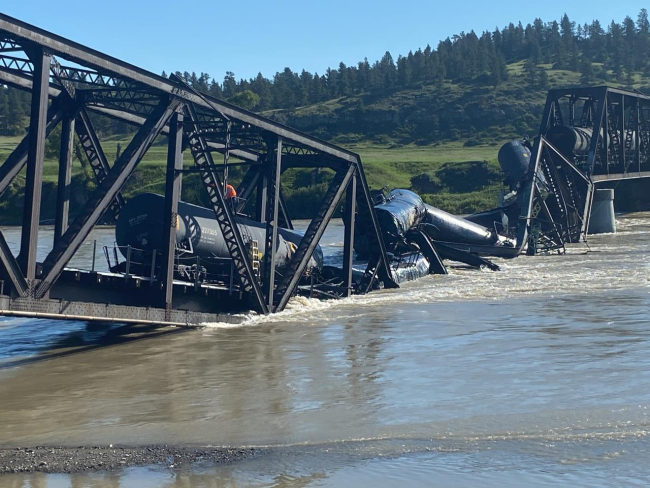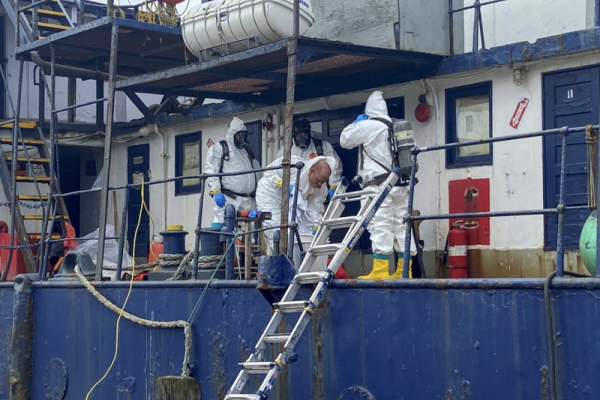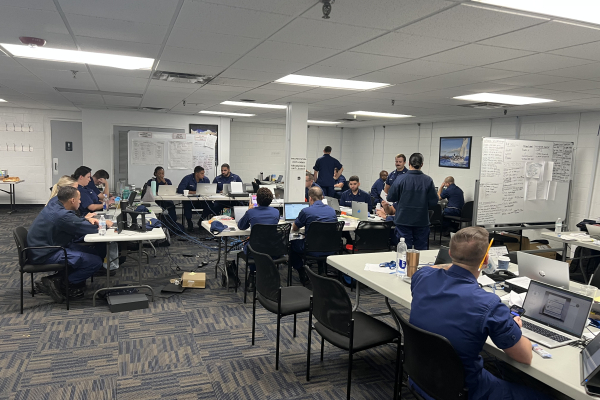The Office of Response and Restoration (OR&R) provides critical scientific support to protect our coastal communities following natural disasters and other incidents that result in marine pollution. Within OR&R, the Emergency Response Division (ERD) provides scientific expertise and services to the U.S. Coast Guard on everything from running oil spill trajectories that model where the spill may spread, to identifying possible effects on wildlife and fisheries, and estimating how long the oil may impact coastal communities and ecology. Additionally, NOAA's Marine Debris Program (MDP) supports national and international partners to respond to large debris caused by major disasters within communities at risk of and responding to impacts from severe weather. At the end of each year, we reflect on the response events and activities that OR&R supported.
In 2023, we provided scientific support to the Coast Guard and other federal responders for a wide range of scenarios—remotely when possible, and on-scene when needed.
The first call of 2023 came on January 3. U.S. Coast Guard Sector Lake Michigan notified the NOAA scientific support coordinator that a 112-foot tug laden with 40,000 gallons of diesel was sinking at the Port of Milwaukee. ERD provided oil trajectory products and weather forecasts. The tug was later refloated without a significant spill. The last incident of the year was a facility fire in Bridgeport, Connecticut on December 29. A large amount of firefighting wastewater entered a storm drain that flowed into Long Island Sound. We provided information on the likely fates of the chemicals entering the marine environment.

During 2023, OR&R provided scientific support for 162 new incidents and continued support for several events that happened in previous years. Responses in 2023 included 132 oil spills, 13 chemical spills, and 17 other incidents—such as severe storms, marine debris, and whale carcass drift requests. Some incidents involved both chemicals and oil, such as a fish processing vessel on fire in Tacoma, Washington, that was carrying diesel fuel and ammonia. Over the year, staff prepared over 1,929 new incident reports and documents.
It’s difficult to determine the total amount of oil and chemicals spilled. Many incidents have approximate volumes or, in the case of mystery spills, may have no estimate. Cumulatively, for incidents with good volume estimates, these incidents in 2023 posed a risk of more than 3.4 million gallons of oil. OR&R also supported responses involving over 6,900 tons of various chemicals. These estimates do not include oil and chemical spills during the 2023 hurricane season or the wildfires on the Hawaiian island of Maui, both of which OR&R responded to.

They also don’t include the various containers and bulk cargoes carried at sea that might have been at risk, such as a freighter on fire carrying over 800 metric tons of lithium batteries, or a car carrier on fire, laden with fuel oil but also thousands of cars. (Note: All spill volumes are approximate and based on initial information that may be updated after further investigation.) I have worked on spills for over 20 years, but I still see things that surprise me. This year, we had a call about a leaking barrel discovered on a shore in Alaska that had been punctured by an interested polar bear, and another about a semi-submersible drug-running submarine abandoned on the shores of Mona Island in Puerto Rico, leaking oil on a sea turtle nesting beach.
OR&R’s incident response work often is in the aftermath of disasters and tragedies—whether it is the loss of life, the loss of a person’s livelihood, or in some cases, entire communities after a hurricane or wildfire. Throughout 2023, the Emergency Response Division and the Marine Debris Program responded to five natural disasters that resulted in oil and chemical spills and large-scale marine debris. Following the devastating Maui wildfires in August 2023, the Emergency Response Division and Marine Debris Program supported the Coast Guard’s mission to assess and remove incident-generated pollution, hazardous materials, and 87 fire-damaged vessels—which was just a small contribution in transitioning that community toward recovery.

During a disaster, once ERD determines there is no threat of oil or chemical impacts, MDP can take the lead on finding effective ways to assist state and local partners in removing large debris. Disaster-related debris can include abandoned and derelict vessels, construction debris, fishing gear, and household waste. These removal projects often take place after the initial response and extend into long term recovery projects. On-the-ground removal support and resources were provided to partners in Florida after Hurricane Idalia, in New England after Hurricane Lee, and remote support provided to partners in Guam after Typhoon Mawar.
I also learned a new term—Jökulhlaup—an Icelandic word for glacial outburst floods. They occur when a lake fed by glacial meltwater breaches its dam and drains catastrophically. Mendenhall Glacier near Juneau, Alaska had a Jökulhlaup last summer, washing away houses and fuel storage tanks.
And let's not forget that response, firefighting, and salvage efforts are often dangerous. Last July, two firefighters in Newark, New Jersey died while responding to the fire on the car carrier Grande Costa d’Avorio. NOAA response products such as GNOME, CAMEO® and ALOHA® are important tools to improve safety, but other NOAA tools, like data related to weather, tides, and currents are also critical to help manage risks while responders work on small vessels and remote shorelines. Although they do not reduce safety risks, marine debris emergency response guides do help communities improve overall preparedness for response and recovery operations following waterway debris incidents.
While 2023 was not quite a record for OR&R, it was certainly a busy year. Most of our responses are in the U.S., but during the year, we also provided support for several international incidents at the specific request of those nations, including in Canada, Mexico, and the Philippines.
In our end-of-the-year tally, we break down our responses by the type of event, whether oil spills, chemical spills, or “other,” but here is a more detailed breakdown.
In 2023, OR&R responded to incidents in 26 states, with the most responses in Louisiana (32), Texas (16), California and Oregon (10 each), and Washington and Alaska (9 each). We also supported three international incidents (Canada, Mexico, and the Philippines), and four U.S. Territories (Puerto Rico, Guam, U.S. Virgin Islands, and Johnston Atoll). The 2023 incidents included:
- 23 mystery spills (some were later identified)
- 20 tug and barge accidents
- 17 production platforms and wellhead leaks
- 12 commercial fishing vessels
- 12 pipeline spills
- 11 facility incidents
- 9 yachts and other pleasure craft
- 7 abandoned and derelict vessels
- 6 tank farm accidents
- 6 container ship and freighter accidents
- 4 vessel fires
- 3 international incidents
- 5 natural disasters (2 hurricanes, 1 typhoon, 1 wildfire, 1 flood, each with multiple spills)
- 3 tank ship accidents
- 3 plane crashes
- 3 tank truck accidents
- 3 U.S. Navy spills
- 3 passenger vessel incidents
- 3 railroad accidents
- 2 missing persons
- 2 chemical containers
- 1 marine debris incident
- 1 harmful algae bloom
- 1 stranded and dead whale
- 1 illegal drug lab spill
- 1 vehicle lost through ice
- 1 downed UFO in the Great Lakes
- 1 drug-smuggling submarine
Looking ahead to 2024, OR&R continues to plan and prepare for accidents, natural biological incidents, severe weather occurrences, and other disasters.







